8 March 2023, San Diego, CA, USA
I have always loved Austria. Felt connected to the place.
Perhaps it is the historical characters that I find so fascinating - it is a beautiful country and culture, and no one makes a chilled red wine like the Austrians. Lucky me, I first experienced Austria when I was 15 years old, on a summer study trip. It was sunny, breezy, lush and green and I had a crush on nearly every young man I saw. The food was wonderful and I spent much of my time exploring outdoors, hiking, in the alps mostly, I can only remember being happy on that trip. Special.
I returned to Austria three days after I graduated from university, my mother, sister and I hit some alpine spa towns, Salzburg and its surrounding areas, and Wien, fabulous fabulous Wien and it felt like coming home. I would trade Vienna for Paris 5 out of 5.1
While this could become a 21st & 18th article devoted to the Pro’s and few Con’s of touristing in Austria, sponsored by the Austrian Gov, I will spare you the reading of such drivel and steer us back in the direction of Two Weeks of Tea.
We have come together this lovely morning for one purpose: Vintage Finds
Vintage Finds is the second article each week here at
, and from my Substack stats, your most favored and voted for chapter. Vintage Finds is when you sit back and enjoy the show, as I unravel the history behind my Vintage Finds, and wait for the zingers to land. Last week, we dove into the history behind a pair of vintage driving gloves acquired for $3.2 This week? We are dissecting two pieces. Pause for elation.The First: An antique Imperial Vienna coffee cup
The Second: A vintage tea length dress
I shall address the former first. Monsieur Espresso Cup? This way please.
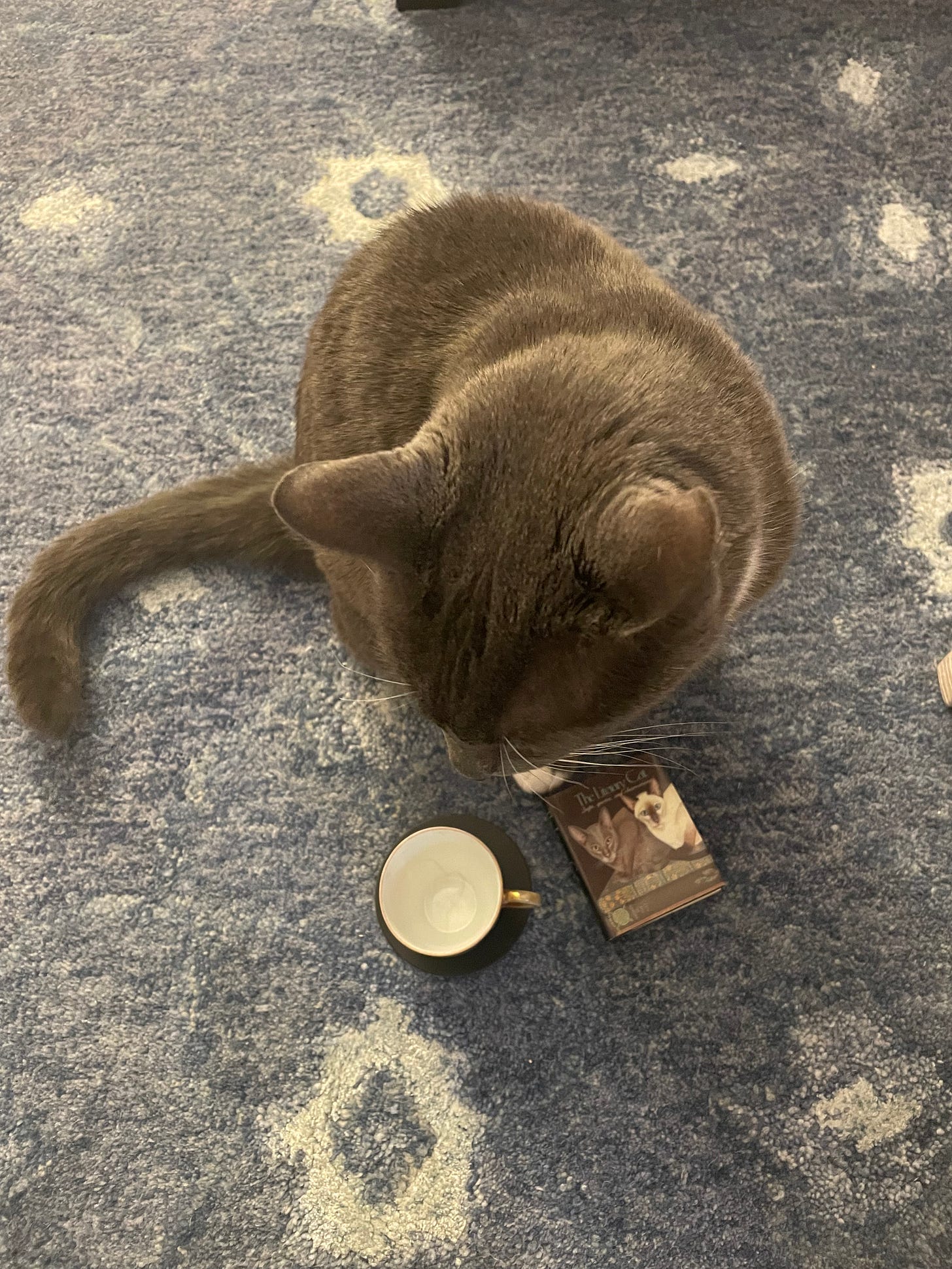
We are making an exception during Two Weeks of Tea for a Vintage Finds mention of a distinctly non-tea accessory, the coffee cup, only because this coffee cup serves as Jasper’s (my dear, dear cat) tea* cup.
So as I was digging into the history of Vienna Porcelain and how we might see it referenced today, I chanced upon this fascinating little Antiques Roadshow Clip, discussing a ‘Royal Vienna-style Plaque c. 1895’ this is a hand-painted porcelain plaque that, based on the 2012 review by the Antiques Roadshow3 Texan host, would go for nearly $6k at auction. Interesting. The more interesting bit is: this piece is decidedly not Royal Vienna, as it is missing the signature blue beehive shield stamped on the piece, rather it has an empty ‘beehive’ alongside a ‘7’ and is estimated to be dated from 1895 when Royal Vienna was disbanded in 1864 - wah wah wah.
Hint: Please do keep this little parable in mind as we dig into Vienna porcelain, and Jasper’s tea* cup.
The year is 1718, both San Antonio and the settlement of New Orleans are founded in North America, a 7.5 earthquake hits Tongwei, Gansu province China4, Voltaire’s5 first play Oedipus premieres in Paris, The Holy Roman Empire, Kingdom of Great Britain, Dutch Republic, and Kingdom of France declare war on Spain, Thomas Chippendale6 is born and William Penn7 dies, and Kaiserlich privilegierte Porcellain Fabrique, or Vienna Porcelain Manufactory, is founded by Claude du Paquier.
Vienna Porcelain Manufactory operated from 1718 through 1864 in Vienna, Austria, and boasts the silver medal for oldest porcelain manufacturer in Europe.8 Vienna Porcelain Manufactory founder, the Dutchman Claude Innocentius du Paquier, was a minor official within the Viennese Imperial court, and privately founded and financed the business in the early 18th century. One year in, du Paquier was granted an exclusive patent - read monopoly - by Emperor Charles VI9 on porcelain for 25 years and launched his business on the historic Porzellangasse10 (Porcelain Lane), during these early days of the company du Paquier was the only porcelain manufacturer to provide wares and take orders from the Imperial family - hence the monopoly - this lasted from 1719 - 1744, or as historians call it, the Du Paquier Period. The porcelain wares the company produced during the Du Paquier period are recognizable by their strong and vibrant coloring and Laub und Bandelwerk, or open work, the technique of sculpting holes, gaps or piercings that create a varied and intricate pattern.
While we may imagine running a porcelain company in 18th century Imperial Vienna to be all glamour and awe, being a founder is tough nuts and in 1744 du Paquier was dried up financially, (likely) creatively and most certainly socially - can you imagine the energy he spent buttering up the Emperor and Empress? After this initial period of working closely with and for the Imperial family but payroll-ing the operation himself, du Paquier gave in only to be rescued from financial ruin by none other than the Empress, Maria Theresa, yes, as in Marie Antoinette’s mum, who stepped in and purchased the Vienna Porcelain Manufactory.

Ever the strategic and creative leader, she renamed it Imperial State Manufactory Vienna.
After this acquisition the company evolves through four more ‘periods’, and as a new creative director at a couture house might put out, these periods are defined by distinctly different styles of porcelain wares.
Plastic period (1744–1784)
Sorgenthal period or Painterly period (Malerische Periode) 1784–1805
Biedermeier period (1805–1833)
Late Biedermeier period (1833–1864)


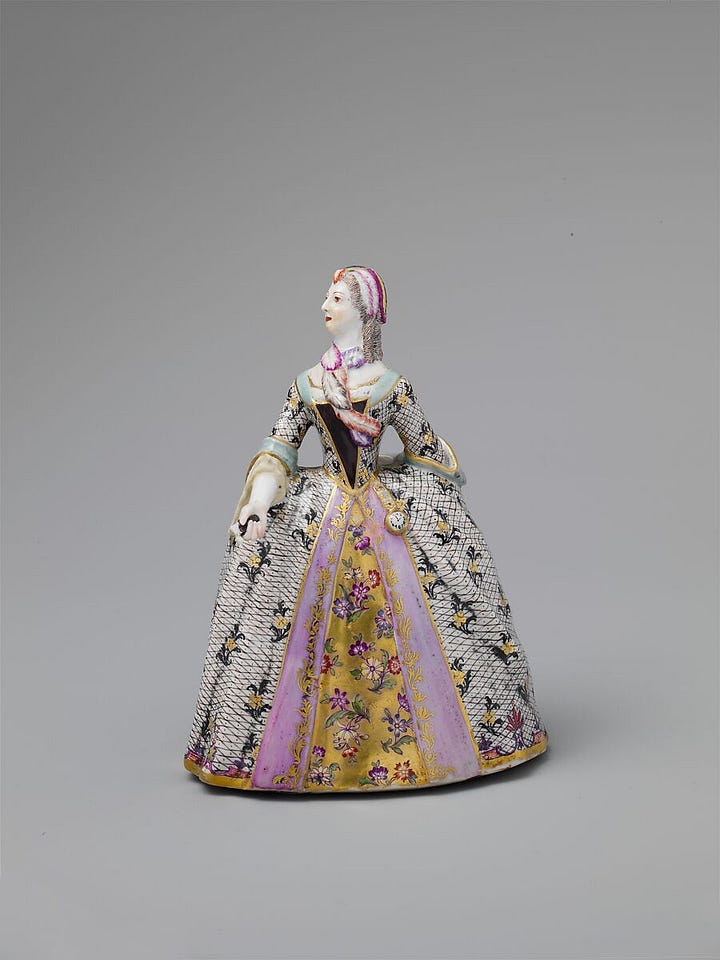
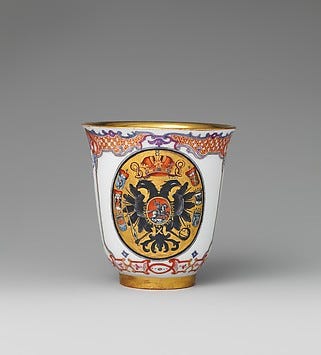
Maria Theresa was keen to get serious about solidifying her company’s porcelain as luxe, collectible, the real deal and begins marking each true Imperial Vienna porcelain piece with a beehive-shaped shield. The shield was marked in either blue or impressed into the porcelain and after 1783 all porcelain pieces were dated with a year, beginning at ‘83’ for 1783 and so on continuing until 1801 with ‘801’.
In the last quarter of the 18th century, Imperial Vienna porcelain was big business, they were cranking out somewhere in the neighborhood of 120k porcelain pieces per year to be exported across the Ottoman Empire. During this period the porcelain cups produced are unmistakable in that they were generally brightly colored, offered painted pastoral or classical scenes and made small for Turkish coffee11, which was enjoyed across the Ottoman Empire.
Alright, this is where we pause.
Fast forward to 2018. San Francisco, California, USA, near Alamo Square Park, an Edwardian era gray home. Me.
I had just moved to San Francisco to begin working at a co-living startup called Bungalow, my boyfriend at the time, Wemple, also moved to SF. We found a lovely, high ceilinged, bay window-ed, bright apartment in the city and moved in together for the first time. The weekend of our move, my mother, Trudie, drove up from San Diego to assist. Upon her arrival, she unloads a few necessities: An ottoman (Trudie, “You can reupholster it”), a few bottles of wine, Art History books from my high school library, and a collection of stemware, champagne flutes and wine, and a porcelain cup.
After a million hours of unpacking and exhausted, we all - my sister was there too - sat down on the floor of my new apartment and cracked one of Trudie’s bottles to toast to newness and goodness. She left the next morning and as I continued to unpack in lovely quiet and warm spring sunlight, I reviewed the things she brought up with her.
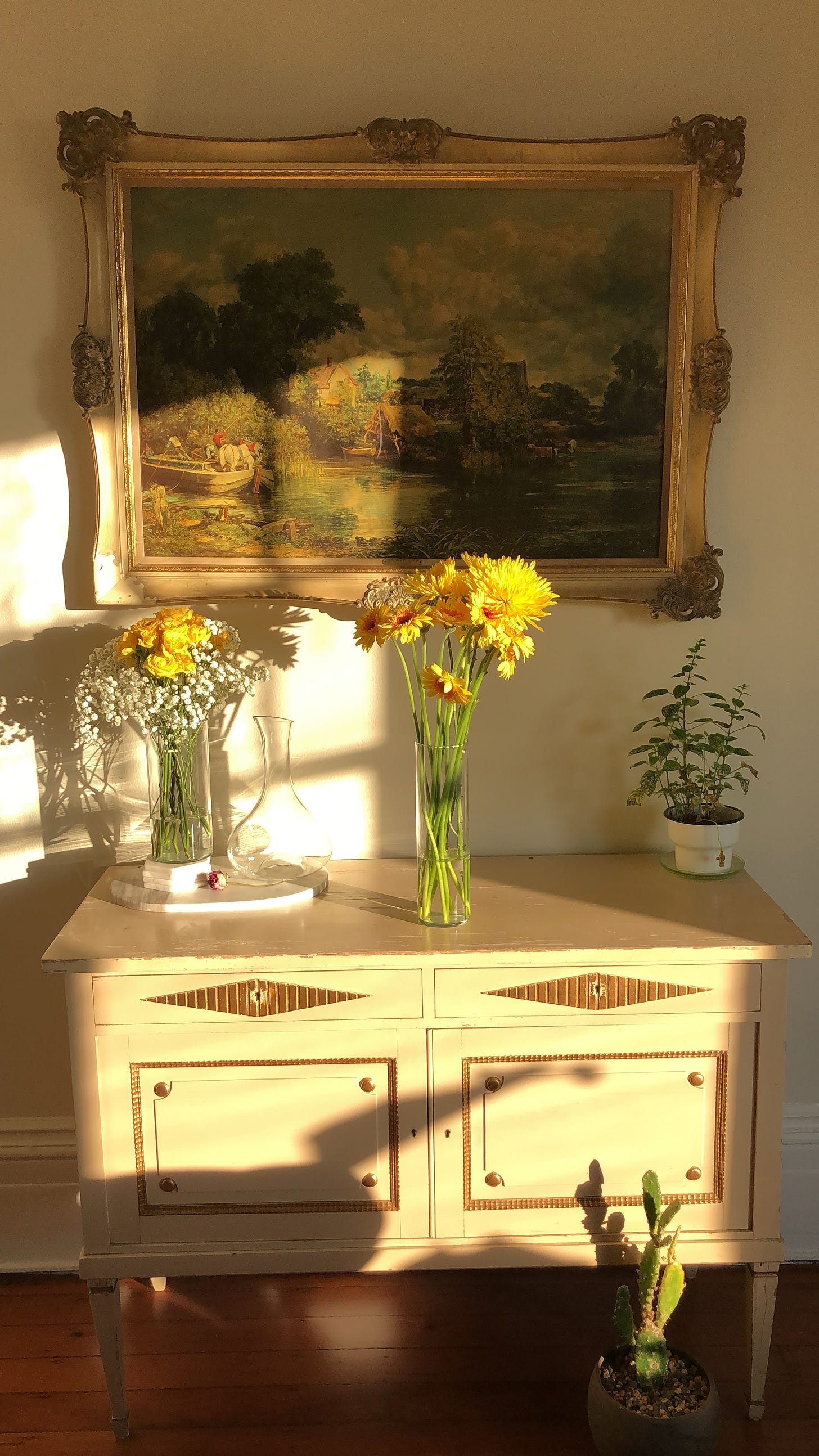
In the collection of glasses I noticed a silly little tea cup? No, too small. A coffee/espresso cup! I did the classic Austen-girl thing and flipped the cup to read the bottom or see a stamp, nothing but a little drawing and ‘Austria’. I thought about throwing it in a drawer as I do not drink coffee but decided to place it, quirkily, in a place of honor on my bookshelf by the fireplace.
Fast forward to New York, NY, 2021, I am living in the West Village in a 4 floor walk up and have, for some reason, brought my family cat, Jasper, with me across the country. Wemple, Jasper and I were living happily, albeit crowded-ly, in NYC. During our days and wonderful time in the city, I felt for Jesperson being so cooped up, and would entertain him with a variety of games and toys (sue me, I love my cat), and started pouring him a “cup” of tea when I would make myself a pot or have a proper afternoon tea at home. The tradition stuck.
Because of him being a cat, a normal teacup and saucer felt ridiculous so I poked around in my collection and, like any sane person, found my little Austrian coffee cup for Jesperson.
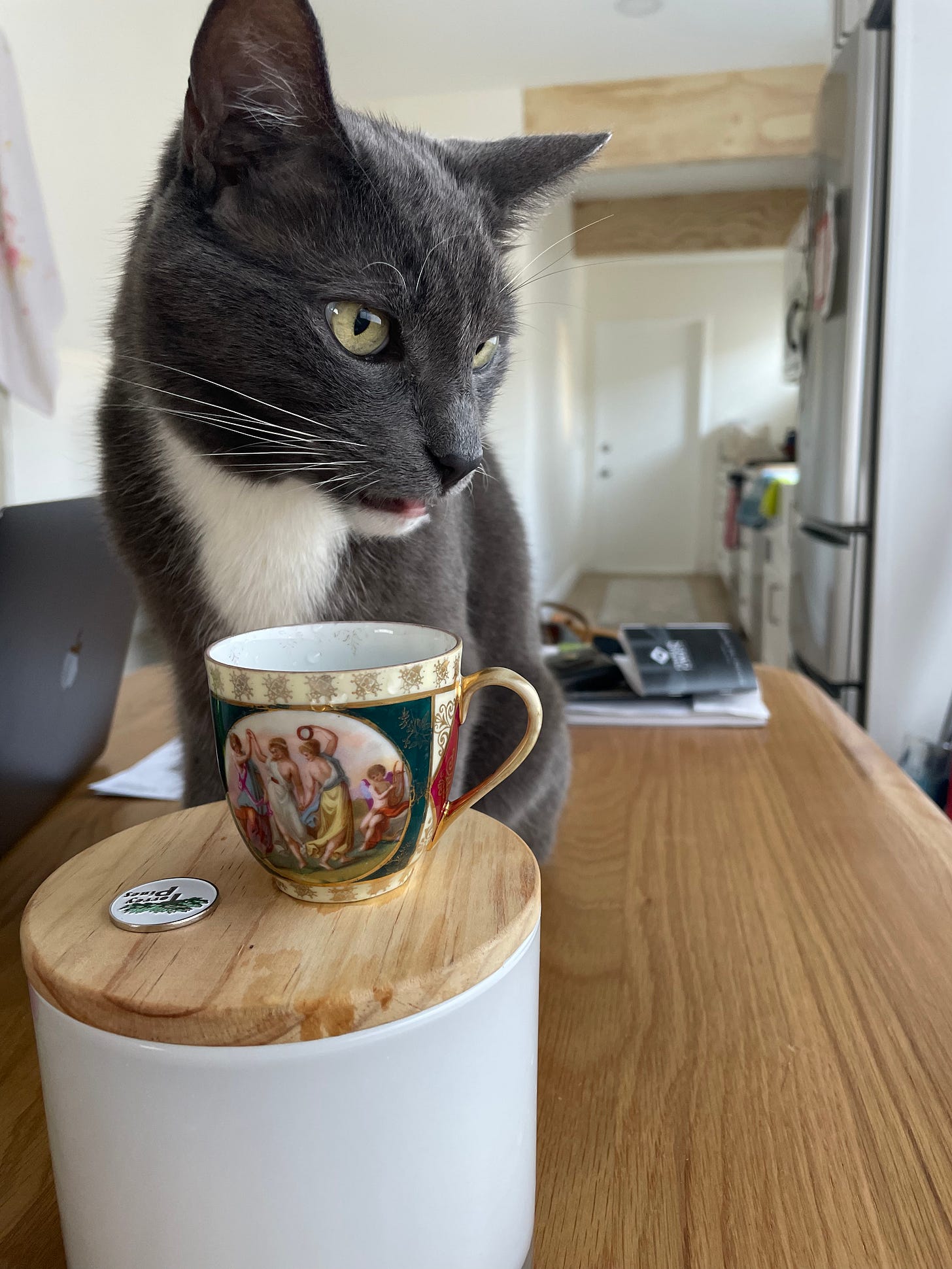
Bringing it back to Imperial Vienna porcelain.
In the late 1700s bright colors and gold embellishments became popular styles for the artisans and creative directors of the porcelain monopoly, and again all porcelain pieces after 1744 were stamped and dated.
Jasper’s tea* cup, you are wondering?
Yes, Reader, you wonder correctly. Jasper’s tea* cup is indeed marked with these critical stamps, in blue, we have the beehive shaped shield, ‘Austria’, and ‘87’. Based on the painting and gold embossed style of the cup together with the markings and date, we can estimate that this cup is hard-paste porcelain from the Imperial State Manufactory Vienna from 1787.
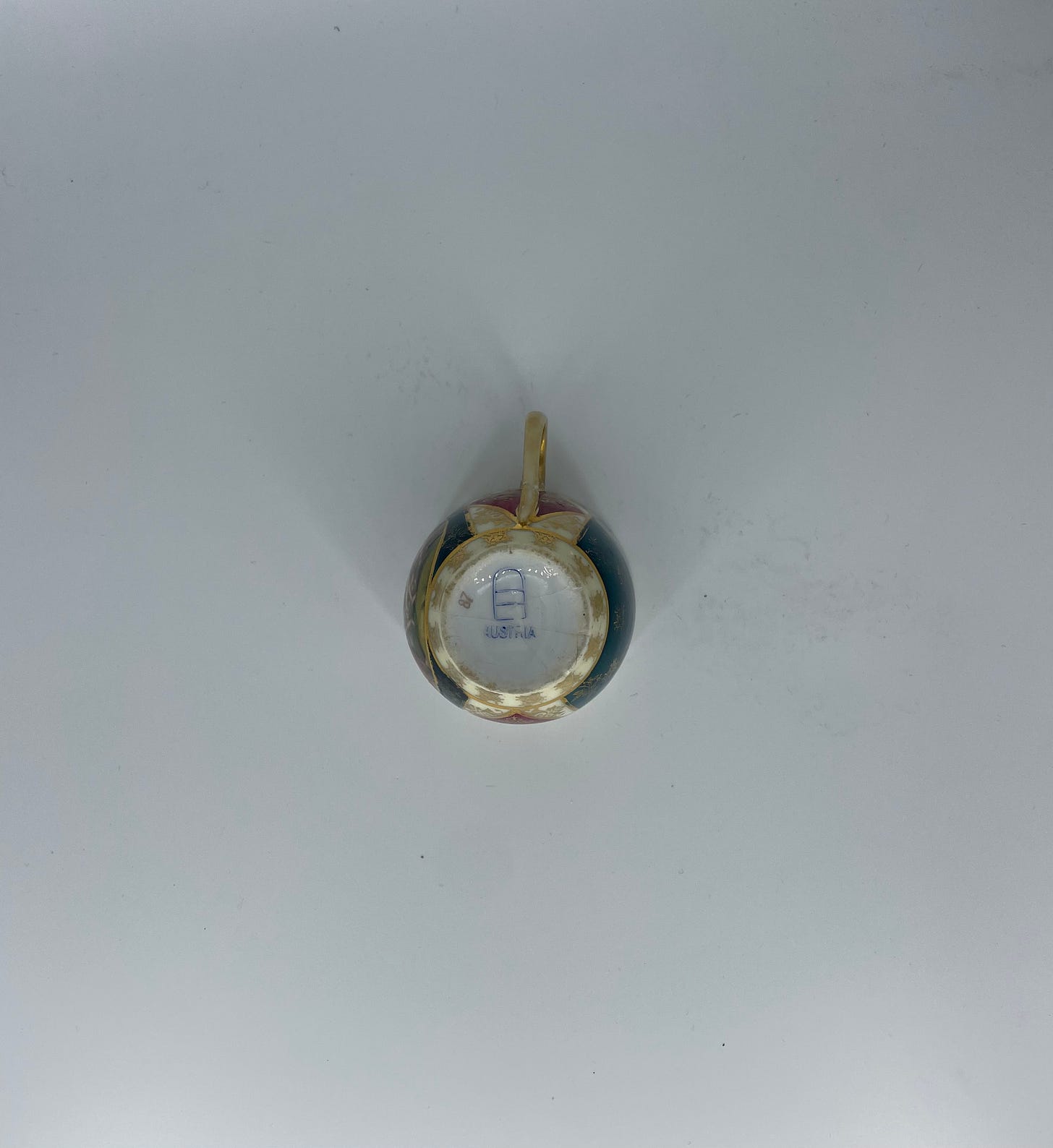
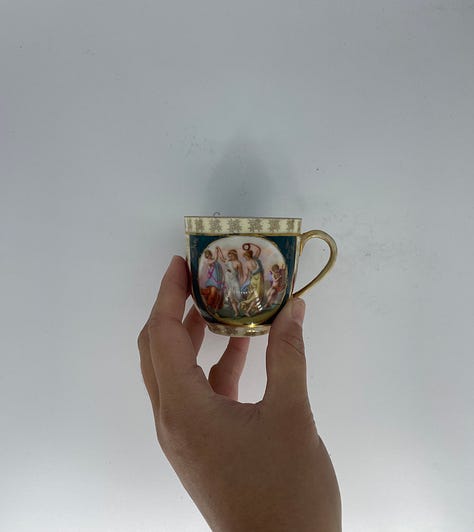
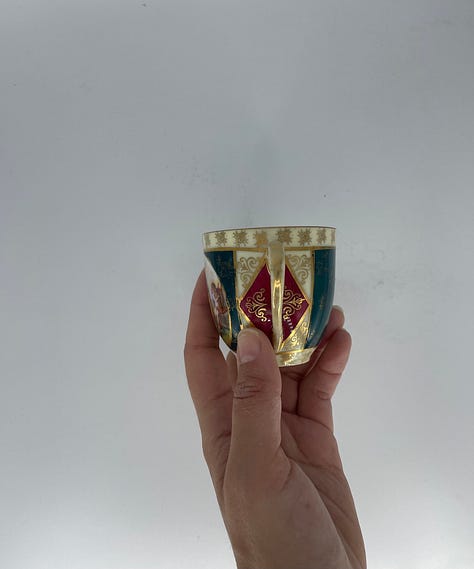
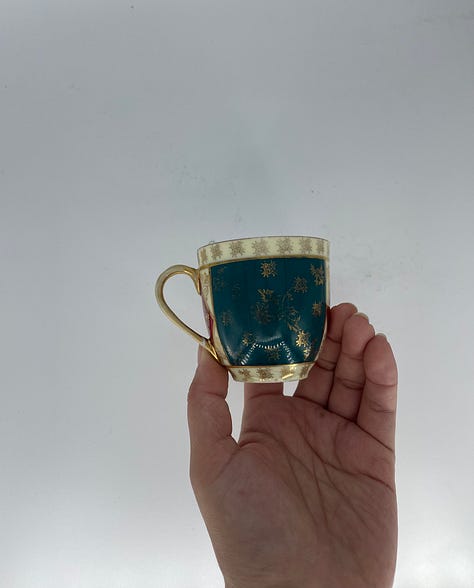
And I have been serving my cat ‘tea’ from Marie Antoinette’s Empress mother’s coffee cup.
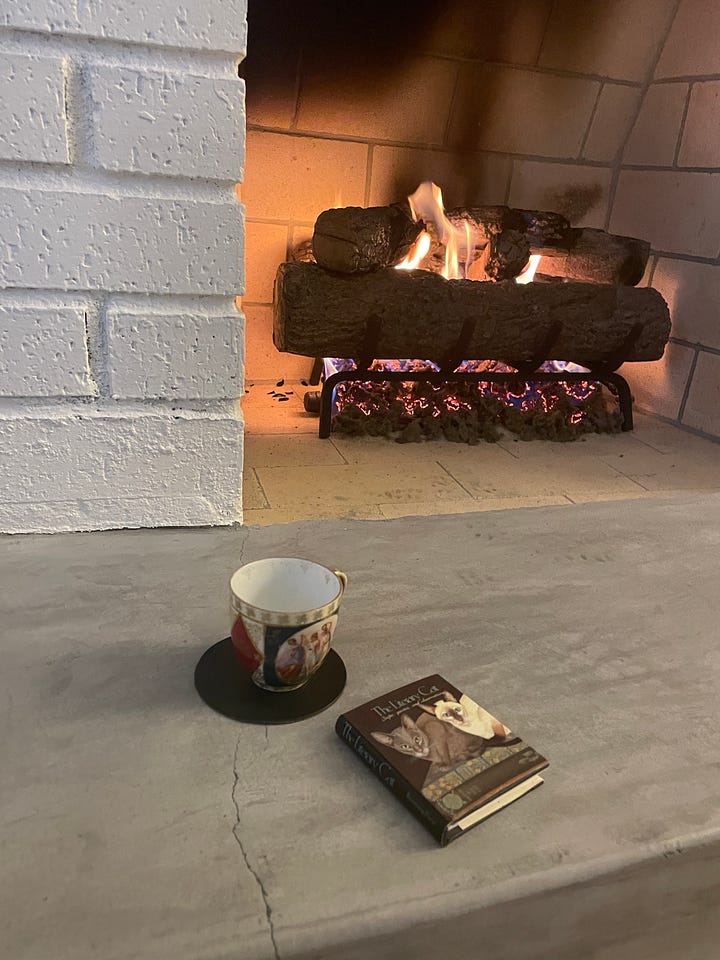
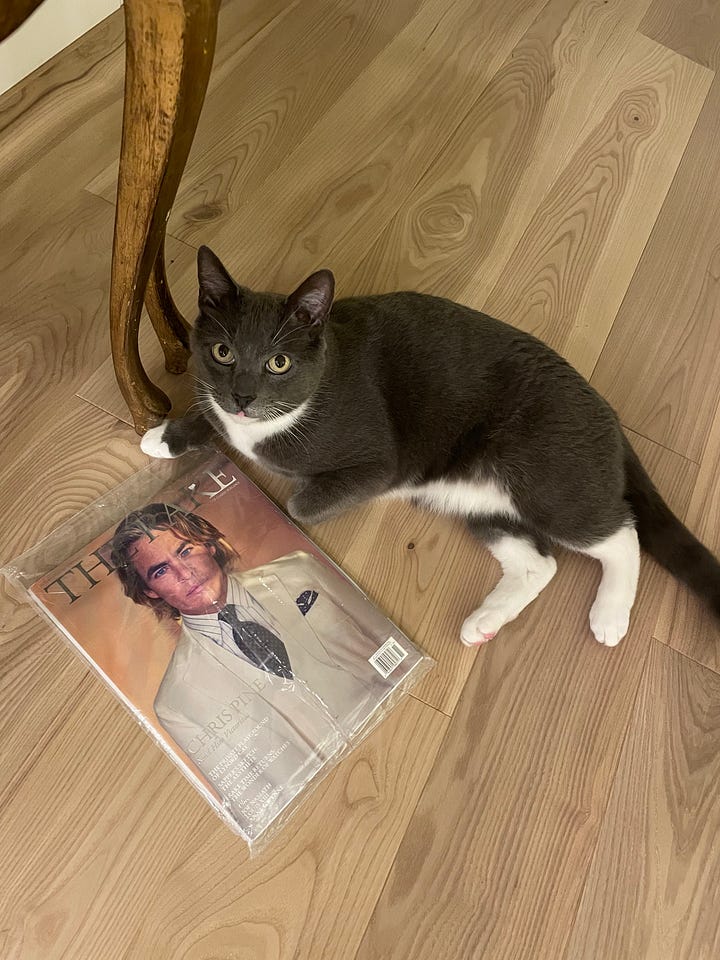
In addition to the necessary markings that date the porcelain, I am confident that this coffee cup is from the Imperial State Manufactory in the late 1700’s as, if you’ll recall, during this time the house was investing in producing over one hundred thousand porcelain coffee cups to be exported across the Ottoman empire. To maximize on capital gains and improve margins, the Imperial State Manufactory invested less time in painting the porcelain wares destined for export outside of Europe, weak of them I know. During this period the porcelain house painted pastoral and classical scenes, that felt distinctly European, on the coffee cups and ensured all pieces of porcelain had the requisite markings to prove these were the real deal coming from Vienna. In 1787 this coffee cup would have had a matching saucer and been one of many in a coffee service.
While I do feel a mite sinful and may have to perform a penance of some sort to the Habsburgs, I honestly feel as though I have won the lotto.
The history lover in me cannot help but consider the events, people and places this little Viennese coffee cup has seen and met: Royals, merchants, Turkey, Habsburg dynasty at its full strength as well as in decline, WWI & II, perhaps it made its way to America in the early 20th century and enjoy prohibition and the Gatsby years and later the Civil Rights Movement. Has it changed hands dozens of times or moved with families as they migrated? How many brother and sister porcelain pieces did it have and where are they now? Broken, orphaned or both? We will never know the experience for sure but we do have some facts - and that that yin and yang puzzle of fact vs. imagination is the incredible, mysterious Bermuda Triangle that keeps us coming back to history. Wondering.
Trudie paid $0.99 for this cup in 2018 when she purchased it from an antique shop in my hometown of Rancho Santa Fe, she threw it in her car to drive to SF, I nearly tossed it in a drawer, it moved to three US cities and became part of Jasper the Cat’s tea service yet these moves are nothing in comparison to the journey this cup must have somehow made to get from 1787 Vienna, Austria to 2023 San Diego, CA.
236 years.
This porcelain coffee cup is approximately 236 years old.
From the Imperial Hofburg in Wien to the Wemple Cottage and Jesperson Von Coates’12 place setting. If porcelain could talk, man.
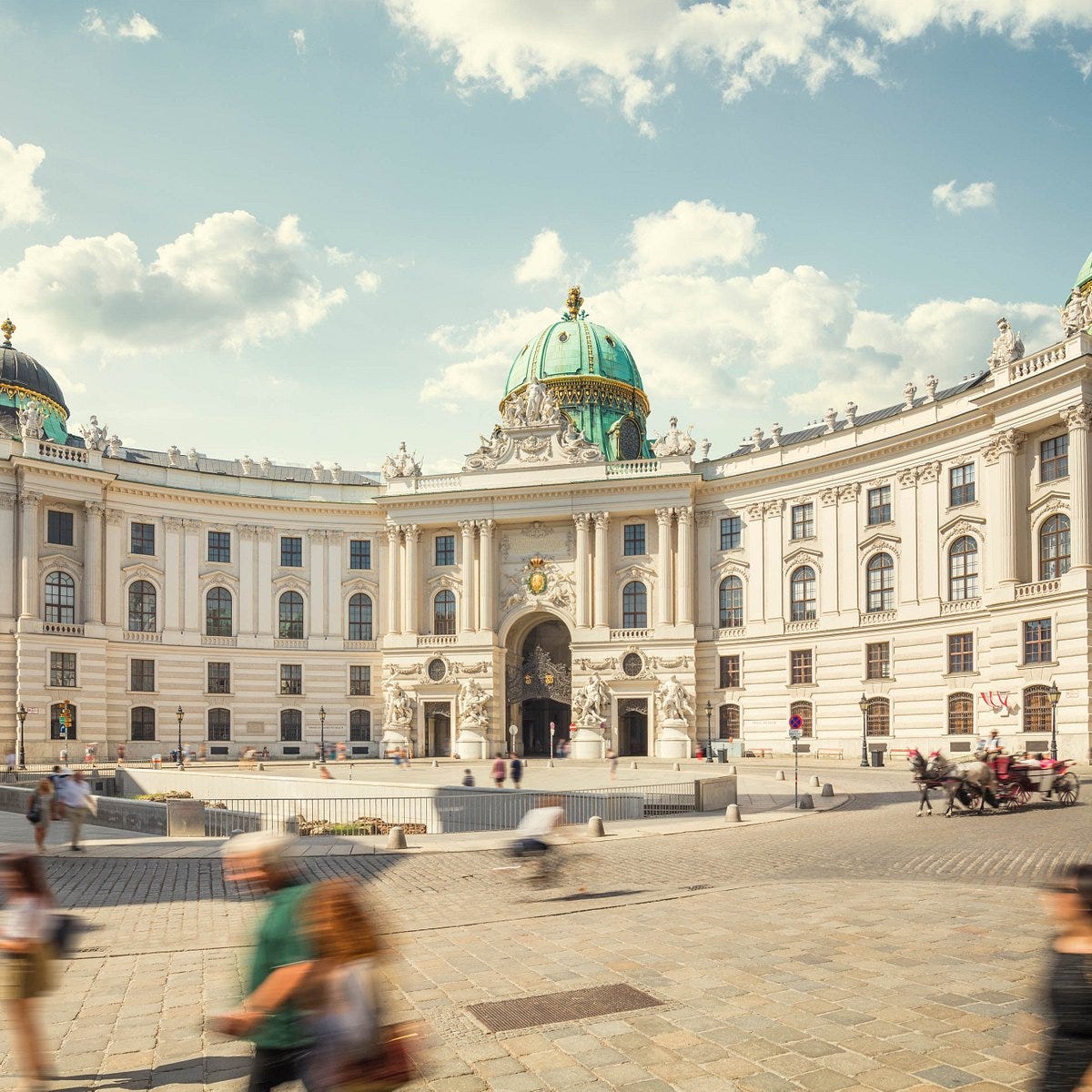
Nowadays,
porcelain from the Imperial State Manufactory in Vienna, the real deal in good condition, one piece, a full set, or a few pieces are worth something. Want proof? Have a look at these sold lots of Royal Vienna porcelain at Christie’s - the realized prices range from £1,650 to £60,000.
Jasper has a nice nest egg for when he finally manages to escape me and move back to Europe.
Given its fascinating history, beauty and expert craftsmanship Imperial Vienna porcelain is perennially on porcelain collectors’ dream shopping lists - as an example, I found this tidy curated collection of the stuff at Los Angeles based antique firm, Arté Antiques - there are certainly Royal Vienna lovers out there. This porcelain has also become a collectible by the art tastemakers among us, for example the The Met in NYC has a strong and very varied collection of the Imperial porcelain, or The Getty’s.
Whether you are a porcelain enthusiast, Antiques Roadshow dabbler or collector of your own unique craft ware - I know we can all appreciate the fact that this Imperial State Manufactory Vienna porcelain coffee cup from 1787 is in the paws and possession of Jesperson Von Coates, personal cat to Lo. Lynch. For me a most delectable part of this story is that Jasper’s tea* cup year, 1787, was a most excellent year for Vienna, particularly music: Beethoven moved to Vienna to attempt to study with Mozart that year (spoiler: it doesn’t happen), Mozart drops Eine kleine Nachtmusik and debuts Don Giovanni in Prague AND is appointed chamber composer to Emperor Joseph II, new music from Bach, Haydn, and so many talented others, and opera from Antonio Salieri - it gives me such a thrill to think of the creative energy flowing through Vienna at the time this porcelain cup was made. Today, that energy survives in my home and we treasure it.

Excuse me, Madame, what about your second Vintage Find?
Ah yes, thank you. Indeed I did have another Vintage Finds find for you, a vivid green tea length dress from the 1950s that makes you want to handjive and hold hands with Danny Zuko however after a discovery such as Jasper’s Tea* Cup, let us end on a high. I’ll save my tea length Betty Draper13 dress for another week at 21st & 18th.
This Sunday we will be back for Chapter III of Two Weeks of Tea: Antiquated Traditions we Must Resuscitate: The Tea Party.
Until then, cheers,
LLW
Of all the European capitals, Paris is the one that feels most akin to New York to me, if you’re not a local or hyper-visitor, I don’t believe you can ever know Paris. That in itself is alluring, but I still prefer Vienna
If I ever have a mid-life crisis, you can find me playing host to Antiques Roadshow hopefuls in the wilds of England and bashing dreams of high value items in England - I’ll be wearing a vintage Gianni Versace suit because Chanel will feel too matronly
Incredibly devastating natural disaster which killed an estimated 73,000 people
French Enlightenment writer, philosopher and historian who was known by his pen name, Voltaire. He was born François-Marie Arouet
Storied English cabinetmaker who is known for producing in the mid-Georgian, English Rococo, and Neoclassical styles. Excellent armoires.
English writer and thinking and later statesman when he founded Pennsylvania in the American colony
#1 is Meissen Porcelain
Marie Antoinette’s Grand-daddy
Within the 9th District, Alsergrund, in Vienna today. Other interesting residents of this district were Ludwig van Beethoven, Sigmund Freud and Franz Schubert
Jasper’s full name
My second Betty Draper reference in three weeks, please read @ JanuaryJones






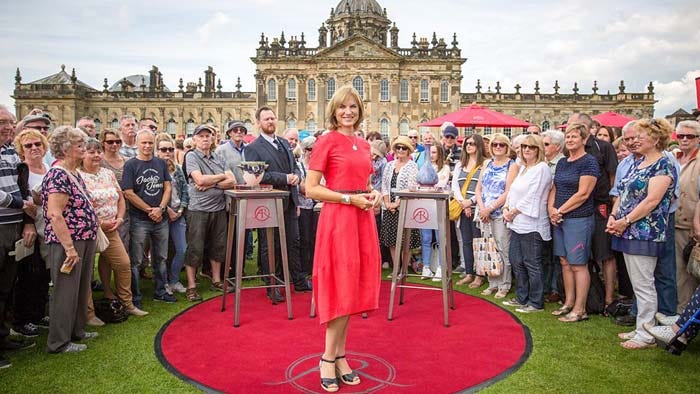
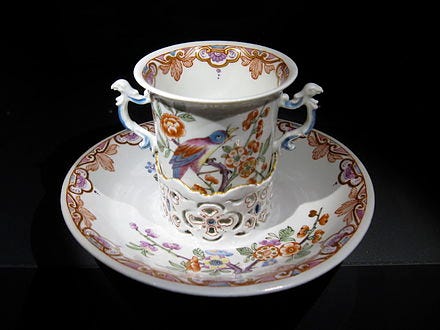


Reading reference list:
https://www.jstor.org/stable/25586794
https://frank.unk.edu/frank/artwork-artists/imperial-and-royal-porcelain-manufactory-of-vienna/
https://www.getty.edu/art/collection/group/103KC1
https://www.metmuseum.org/art/collection/search?q=Imperial+Porcelain+Manufactory+&sortBy=Relevance&pageSize=0